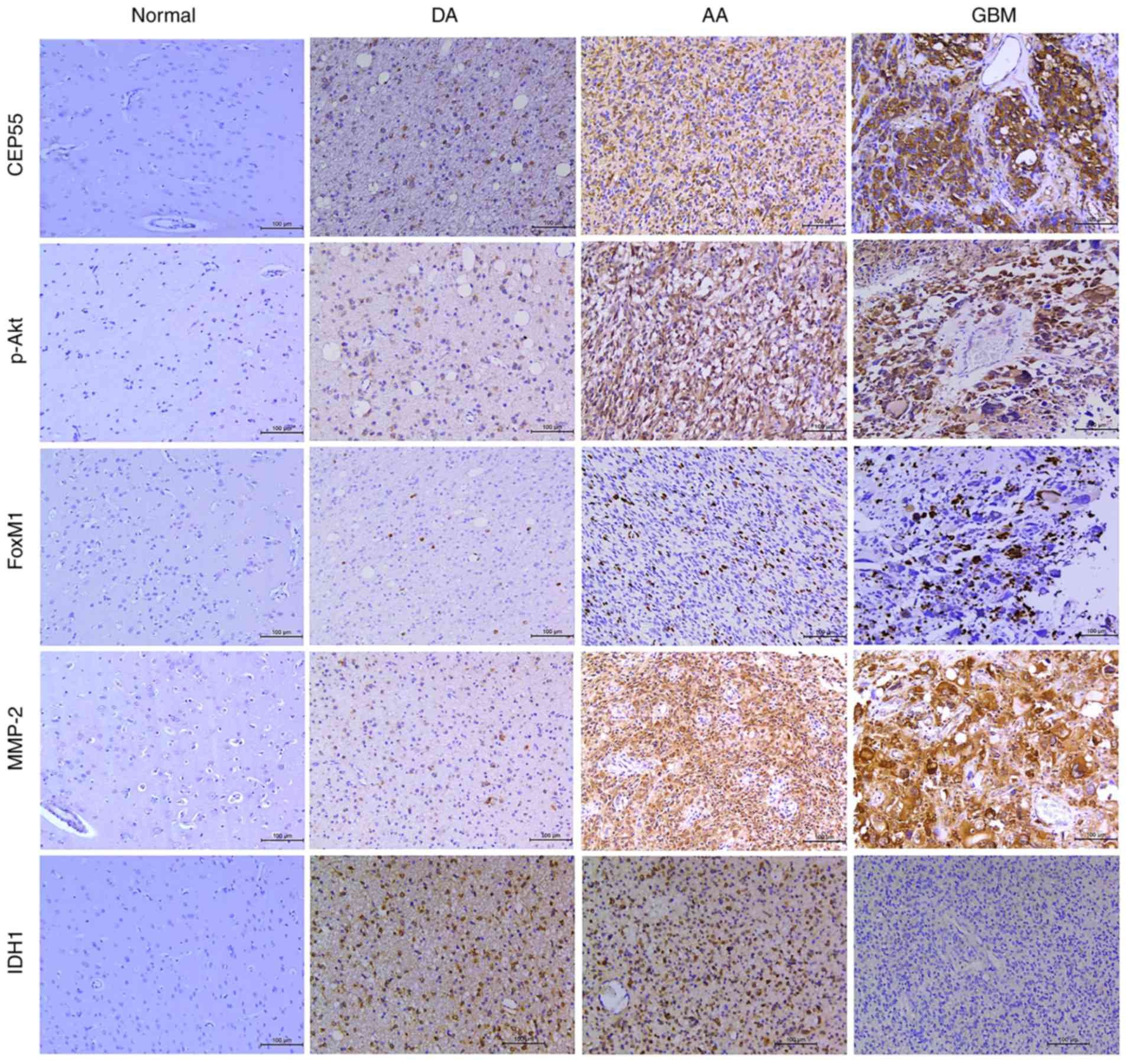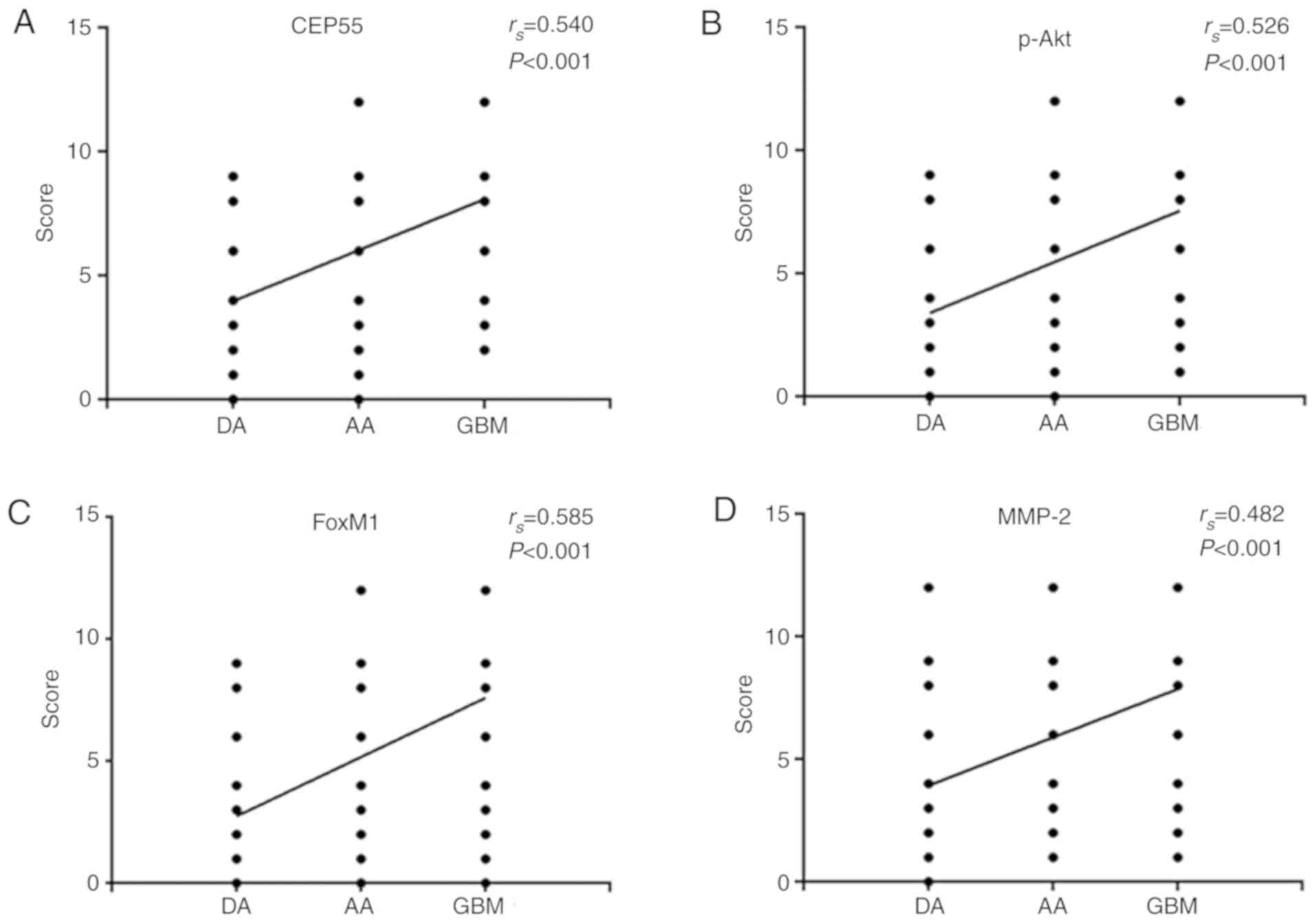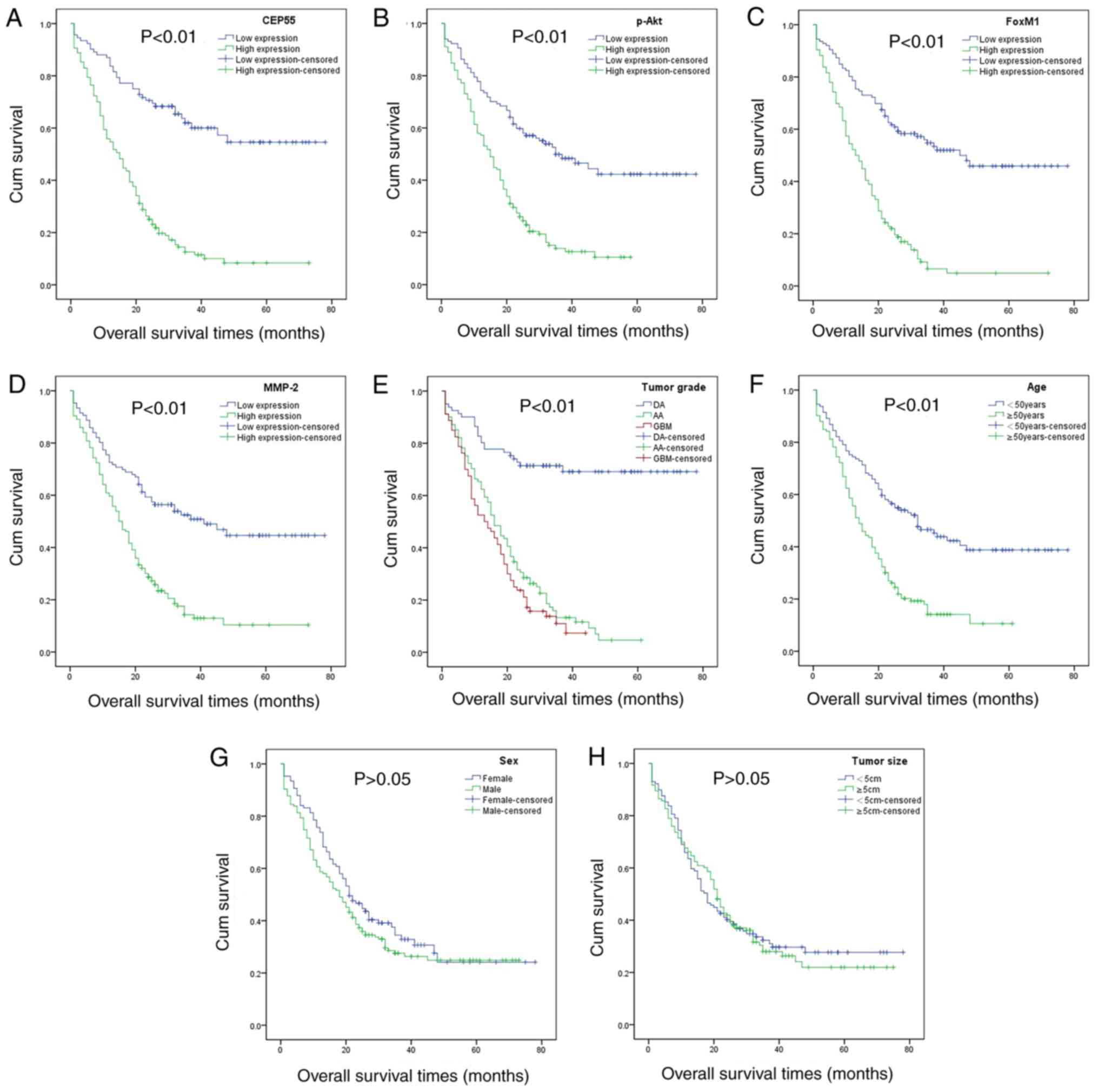|
1
|
Surawicz TS, Davis F, Freels S, Laws ER Jr
and Menck HR: Brain tumor survival: Results from the national
cancer data base. J Neurooncol. 40:151–160. 1998. View Article : Google Scholar : PubMed/NCBI
|
|
2
|
Ostrom QT, Gittleman H, Fulop J, Liu M,
Blanda R, Kromer C, Wolinsk Y, Kruchko C and Barnholtz-Sloan JS:
CBTRUS statistical report: Primary brain and central nervous system
tumors diagnosed in the United States in 2008–2012. Neuro Oncol. 17
(Suppl 4):iv1S–iv62S. 2015. View Article : Google Scholar
|
|
3
|
Agnihotri S, Alddape KD and Zadeh G:
Isocitrate dehydrogenase status and molecular subclasses of glioma
and glioblastoma. Neurosurg Focus. 37:E132014. View Article : Google Scholar : PubMed/NCBI
|
|
4
|
Yan H, Parsons DW, Jin G, McLendon R,
Rasheed BA, Yuan W, Kos I, Batinic-Haberle I, Jones S, Riggins GJ,
et al: IDH1 and IDH2 mutations in gliomas. N Engl J Med.
360:765–73. 2009. View Article : Google Scholar : PubMed/NCBI
|
|
5
|
Louis DN, Perry A, Reifenberger G, von
Deimling A, Figarella-Branger D, Cavenee WK, Ohgaki H, Wiestler OD,
Kleihues P and Ellison DW: The 2016 world health organization
classification of tumors of the central nervous system: A summary.
Acta Neuropathol. 131:803–820. 2016. View Article : Google Scholar : PubMed/NCBI
|
|
6
|
Fabbro M, Zhou BB, Takahashi M, Sarcevic
B, Lal P, Graham ME, Gabrielli BG, Robinson PJ, Niqq EA, Ono Y and
Khanna KK: Cdk1/Erk2- and Plk1-dependent phosphorylation of a
centrosome protein, Cep55, is required for its recruitment to
midbody and cytokinesis. Dev cell. 9:477–488. 2005. View Article : Google Scholar : PubMed/NCBI
|
|
7
|
Singh PK, Srivastava AK, Rath SK, Dalela
D, Goel MM and Bhatt ML: Expression and clinical significance of
centrosomal protein 55 (CEP55) in human urinary bladder
transitiona-l cell carcinoma. Immunobiology. 220:103–108. 2015.
View Article : Google Scholar : PubMed/NCBI
|
|
8
|
Jiang W, Wang Z and Jia Y: CEP55
overexpression predicts poor prognosis in patients with locally
advanced esophageal squamous cell carcinoma. Oncol Lett.
13:236–242. 2017. View Article : Google Scholar : PubMed/NCBI
|
|
9
|
Qi J, Liu G and Wang F: High levels of
centrosomal protein 55 expression is associated with poor clinical
prognosis in patients with cervical cancer. Oncol Lett.
15:9347–9352. 2018.PubMed/NCBI
|
|
10
|
Tao J, Zhi X, Tian Y, Li Z, Zhu Y, Wang W,
Xie K, Tang J, Zhang X, Wang L and Xu Z: CEP55 contributes to human
gastric carcinoma by regulating cell proliferation. Tumour Biol.
35:4389–4399. 2014. View Article : Google Scholar : PubMed/NCBI
|
|
11
|
Chen CH, Lu PJ, Chen YC, Fu SL, Wu KJ,
Tsou AP, Lee YCG, Lin TCE, Hsu SL, Lin WJ, et al: FLJ10540-elicited
cell transformation is through the activation of PI3-kinase/AKT
pathway. Oncogene. 26:4272–4283. 2007. View Article : Google Scholar : PubMed/NCBI
|
|
12
|
Jeffery J, Sinha D, Srihari S, Kalimutho M
and Khanna KK: Beyond cytokinesis: The emerging roles of CEP55 in
tumorigenesis. Oncogene. 35:683–690. 2016. View Article : Google Scholar : PubMed/NCBI
|
|
13
|
Xu L, Xia C, Sheng F, Sun Q, Xiong J and
Wang S: CEP55 promotes the proliferation and invasion of tumour
cells via the AKT signalling pathway in osteosarcoma.
Carcinogenesis. 39:623–631. 2018. View Article : Google Scholar : PubMed/NCBI
|
|
14
|
Chen CH, Lai JM, Chou TY, Chen CY, Su LJ,
Lee YC, Cheng TS, Hong YR, Chou CK, Whang-Peng J, et al: VEGFA
upregulates FLJ10540 and modulates migration and invasion of lung
cancer via PI3K/AKT pathway. PLoS One. 4:e50522009. View Article : Google Scholar : PubMed/NCBI
|
|
15
|
Kaestner KH, Knochel W and Martinez DE:
Unified nomenclature for the winged helix/forkhead transcription
factors. Genes Dev. 14:142–146. 2000.PubMed/NCBI
|
|
16
|
Chen H, Wang J, Yang H, Chen D and Li P:
Association between FOXM1 and hedgehog signaling pathway in human
cervical carcinoma by tissue microarray analysis. Oncol Lett.
12:2664–2673. 2016. View Article : Google Scholar : PubMed/NCBI
|
|
17
|
Wei P, Zhang N, Wang Y, Li D, Wang L, Sun
X, Shen C, Yang Y, Zhou X and Du X: FOXM1 promotes lung
adenocarcinoma invasion and metastasis by upregulating SNAIL. Int J
Biol Sci. 11:186–198. 2015. View Article : Google Scholar : PubMed/NCBI
|
|
18
|
Liu M, Dai B, Kang SH, Ban K, Huang FJ,
Lang FF, Aldape KD, Xie TX, Pelloski CE, Xie K, et al: FoxM1B is
overexpressed in human glioblastomas and critically regulates the
tumorigenicity of glioma cells. Cancer Res. 66:3593–3602. 2006.
View Article : Google Scholar : PubMed/NCBI
|
|
19
|
Major ML, Lepe R and Costa RH: Forkhead
box M1B transcriptional activity requires binding of Cdk-cyclin
complexes for phosphorylation-dependent recruitment of p300/CBP
coactivators. Mol Cell Biol. 24:2649–2661. 2004. View Article : Google Scholar : PubMed/NCBI
|
|
20
|
Li Y, Zhang T, Zhang Y, Zhao X and Wang W:
Targeting the FOXM1-regulated long noncoding RNA TUG1 in
osteosarcoma. Cancer Sci. 109:3093–3104. 2018. View Article : Google Scholar : PubMed/NCBI
|
|
21
|
Wang Z, Li Y, Ahmad A, Banerjee S, Azmi
AS, Kong D, Wojewoda C, Miele L and Sarkar FH: Down-regulation of
Notch-1 is associated with Akt and FoxM1 in inducing cell growth
inhibition and apoptosis in prostate cancer cells. J Cell Biochem.
112:78–88. 2011. View Article : Google Scholar : PubMed/NCBI
|
|
22
|
Miyashita A, Fukushima S, Nakahara S,
Yamashita J, Tokuzumi A, Aoi J, Ichihara A, Kanemaru H, Jinnin M
and Ihn H: Investigation of FOXM1 as a potential new target for
Melanoma. PLoS One. 10:e01442412015. View Article : Google Scholar : PubMed/NCBI
|
|
23
|
Chen W, Yuan K, Tao ZZ and Xiao BK:
Deletion of forkhead BoxM1 transcription factor reduces malignancy
in laryngeal squamous carcinoma cells. Asian Pac J Cancer Prev.
12:1785–1788. 2011.PubMed/NCBI
|
|
24
|
Ahmad A, Wang Z, Kong D, Ali S, Li Y,
Banerjee S, Ali R and Sarkar FH: FoxM1 down-regulation leads to
inhibition of proliferation, migration and invasion of breast
cancer cells through the modulation of extra-cellular matrix
degrading factors. Breast Cancer Res Treat. 122:337–346. 2010.
View Article : Google Scholar : PubMed/NCBI
|
|
25
|
Chen CH, Chien CY, Huang CC, Hwang CF,
Chuang HC, Fang FM, Huang HY, Chen CM, Liu HL and Huang CY:
Expression of FLJ10540 is correlated with aggressiveness of oral
cavity squamous cell carcinoma by stimulating cell migration and
invasion through increased FOXM1 and MMP-2 activity. Oncogene.
28:2723–2737. 2009. View Article : Google Scholar : PubMed/NCBI
|
|
26
|
Ma S, Pang C, Song L, Guo F and Sun H:
Activating transcription factor 3 is overexpressed in human glioma
and its knockdown in glioblastoma cells causes growth inhibition
both in vitro and in vivo. Int J Mol Med.
35:1561–1573. 2015. View Article : Google Scholar : PubMed/NCBI
|
|
27
|
Ma Q, Zhou B and Zhang J: Expression and
clinical significance of FoxM1 and Cep55 in basal-like breast
cancer. Hebei Med J. 37:5–9. 2015.(In Chinese).
|
|
28
|
Chen L, Cao T, Li S, Luo L and Yang Y:
Expression of FOXO3a in epithelial ovarian cancer and its
correlation with clinicopathological features. Med J West China.
31:670–678. 2019.(In Chinese).
|
|
29
|
Chen GQ, Yao ZW and Luo X: Expression and
clinical significance of FOXM1 in epithelial ovarian carcinoma.
Life Sci Res. 15:70–74. 2011.(In Chinese).
|
|
30
|
Zhong Z, He ZW, Qiu Y, Ren NJ, Gao HB and
Zhang K: Expression and corelation of MMP-2 and Ki-67 in human
glioma tissues. Chin J Cancer Prev T Reat. 17:1070–1072. 2010.(In
Chinese).
|
|
31
|
Shimizu Y, Segawa T, Inoue T, Shiraishi T,
Yoshida T, Toa Y, Yamada T, Kinukawa N, Terada N, Kobayashi H, et
al: Increased Akt and phosphorylated Akt expression are associated
with malignant biological features of prostate cancer in Japanese
men. BJU Int. 100:685–690. 2007. View Article : Google Scholar : PubMed/NCBI
|
|
32
|
Rychahou PG, Kang J, Gulhati P, Doan HQ,
Chen LA, Xiao SY, Chung DH and Evers BM: Akt2 overexpression plays
a critical role in the establishment of colorectal cancer
metastasis. Proc Natl Acad Sci USA. 105:20315–20320. 2008.
View Article : Google Scholar : PubMed/NCBI
|
|
33
|
Kim IM, Ackerson T, Ramakrishna S,
Tretiakova M, Wang IC, Kalin TV, Major ML, Gusarova GA, Yoder HM,
Costa RH and Kalinichenko VV: The Forkhead Box m1 transcription
factor stimulates the proliferation of tumor cells during
development of lung cancer. Cancer Res. 66:2153–2161. 2006.
View Article : Google Scholar : PubMed/NCBI
|
|
34
|
Janus JR, Laborde RR, Greenberg AJ, Wang
VW, Wei W, Trier A, Olsen SM, Moore EJ, Olsen KD and Smith DI:
Linking expression of FOXM1,CEP55 and HELLS to tumorigenesis in
oropharyngeal squamous cell carcinoma. Laryngoscope. 121:2598–2603.
2011. View Article : Google Scholar : PubMed/NCBI
|
|
35
|
Wen N, Wang Y, Wen L, Zhao SH, Ai ZH, Wang
Y, Wu B, Lu HX, Yang H, Liu WC and Li Y: Overexpression of FOXM1
predicts poor prognosis and promotes cancer cell proliferation,
migration and invasion in epithelial ovarian cancer. J Transl Med.
12:1342014. View Article : Google Scholar : PubMed/NCBI
|
|
36
|
Sullu Y, Demiraq GG, Yildirim A, Karaqoz F
and Kandemir B: Matrix metalloproteinase-2 (MMP-2) and MMP-9
expression in invasive ductal carcinoma of the breast. Pathol Res
Pract. 207:747–753. 2011. View Article : Google Scholar : PubMed/NCBI
|
|
37
|
Coticchia CM, Curatolo AS, Zurakowski D,
Yang J, Daniels KE, Matulonis UA and Moses MA: Urinary MMP-2 and
MMP-9 predict the presence of ovarian cancer in women with normal
CA125 levels. Gynecol Oncol. 123:295–300. 2011. View Article : Google Scholar : PubMed/NCBI
|
|
38
|
Peng WJ, Zhang JQ, Wang BX, Pan HF, Lu MM
and Wang J: Prognostic value of matrix metalloproteinase 9
expression in patients with non-small cell lung cancer. Clin Chim
Acta. 413:1121–1126. 2012. View Article : Google Scholar : PubMed/NCBI
|
|
39
|
Dai B, Kang SH, Gong W, Liu M, Aldape KD,
Sawaya R and Huang S: Aberrant FoxM1B expression increases matrix
metalloproteinase-2 transcription and enhances the invasion of
glioma cells. Oncogene. 26:6212–6219. 2007. View Article : Google Scholar : PubMed/NCBI
|
|
40
|
Jiang C, Zhang Y, Li Y, Lu J, Huang Q, Xu
R, Feng Y and Yan S: High CEP55 expression is associated with poor
prognosis in non-small-cell lung cancer. Onco Targets Ther.
11:4979–4990. 2018. View Article : Google Scholar : PubMed/NCBI
|
|
41
|
Inoda S, Hirohashi Y, Torigoe T,
Nakatsugawa M, Kiriyama K, Nakazawa E, Harada K, Takasu H, Tamura
Y, Kamiguchi K, et al: Cep55/c10orf3, a tumor antigen derived from
a centrosome residing protein in breast carcinoma. J Immunother.
32:474–485. 2009. View Article : Google Scholar : PubMed/NCBI
|
|
42
|
Coutant C, Rouzier R, Qi Y, Lehmann-Che J,
Bianchini G, Lwamoto T, Hortobagyi GN, Symmans WF, Uzan S, Andre F,
et al: Distinct p53 gene signatures are needed to predict prognosis
and response to chemotherapy in ER-positive and ER-negative breast
cancers. Clin Cancer Res. 17:2591–2601. 2011. View Article : Google Scholar : PubMed/NCBI
|
|
43
|
Dai J, Yang L, Wang J, Xiao Y and Ruan Q:
Prognostic value of FOXM1 in patients with malignant solid tumor: A
meta-analysis and system review. Dis Markers. 2015:3524782015.
View Article : Google Scholar : PubMed/NCBI
|

















